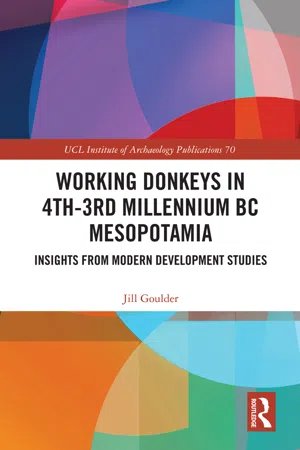
Working Donkeys in 4th-3rd Millennium BC Mesopotamia
Insights from Modern Development Studies
- 184 pages
- English
- ePUB (mobile friendly)
- Available on iOS & Android
Working Donkeys in 4th-3rd Millennium BC Mesopotamia
Insights from Modern Development Studies
About This Book
Working Donkeys in 4th-3rd Millennium BC Mesopotamia: Insights from Modern Development Studies is a reassessment of the role and impact of working-animal adoption in antiquity, focusing on 4th-3rd millennium BC Mesopotamia but applicable to other periods and regions.
This book is driven by a novel interdisciplinary process of analogy with modern use of working donkeys and cattle in sub-Saharan Africa and elsewhere. The author uses close qualitative analysis of nearly 400 published official and NGO development studies of the complex practicalities of adoption of working animals in developing regions worldwide, in particular of the invisible and under-appreciated donkey. This material, little-used as yet in Ancient Near Eastern archaeology, sheds light on the day-to-day practicalities of working-animal adoption and management – breeding, training, husbandry, hiring and lending. While archaeology will always have need of large-scale anthropological models, the author argues for a parallel bottom-up ethological approach, envisaging the 4th and 3rd millennia BC in Mesopotamia from a viewpoint explicitly acknowledging the major presence of working animals and their daily impact on human activity and the consequent archaeological record.
This innovatory investigation of the role and impact of the donkey in the Ancient Near East and today is an essential handbook for Ancient Near Eastern archaeology and zooarchaeology researchers and students, as well as historians, anthropologists and ethnographers examining the impact of working animals on past and present societies. Wider audiences include the growing sector of human-animal relationship studies, and NGOs concerned with the use of working donkeys worldwide.
Frequently asked questions
Information
Table of contents
- Cover
- Half Title
- Series Page
- Title
- Copyright
- Dedication
- Contents
- List of figures
- List of tables
- Acknowledgements
- Preface
- 1 Working donkeys then and now: approaches and contexts
- 2 Working animals in antiquity
- 3 Donkeys versus cattle
- 4 Working-animal supply logistics
- 5 Training, husbandry and feeding
- 6 Transport
- 7 Rethinking animal ploughing
- 8 Summing up: the way forward
- Appendices
- Bibliography
- Index